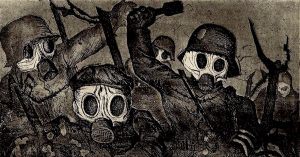W. Scott Poole at Literary Hub:
 “The war has left its imprint in our souls [with] all these visions of horror it has conjured up around us,” wrote French author Pierre de Mazenod in 1922, describing the Great War. His word, horreur, appears in various forms in an incredible number of accounts of the war, written by English, German, Austrian, French, Russian, and American veterans. The years following the Great War became the first time in human history the word “horror” and its cognates appeared on such a massive scale. Images of catastrophe abounded. The Viennese writer Stefan Zweig, one of the stars in the firmament of central Europe’s decadent and demonic café culture before 1914, wrote of how “bridges are broken between today and tomorrow and the day before yesterday” in the conflict’s wake. Time was out of joint. When not describing the war as horror, the imagery of all we would come to associate with the word appeared. One French pilot passing over the ruined city of Verdun described the landscape as a haunted waste and a creature of nightmare, “the humid skin of a monstrous toad.”
“The war has left its imprint in our souls [with] all these visions of horror it has conjured up around us,” wrote French author Pierre de Mazenod in 1922, describing the Great War. His word, horreur, appears in various forms in an incredible number of accounts of the war, written by English, German, Austrian, French, Russian, and American veterans. The years following the Great War became the first time in human history the word “horror” and its cognates appeared on such a massive scale. Images of catastrophe abounded. The Viennese writer Stefan Zweig, one of the stars in the firmament of central Europe’s decadent and demonic café culture before 1914, wrote of how “bridges are broken between today and tomorrow and the day before yesterday” in the conflict’s wake. Time was out of joint. When not describing the war as horror, the imagery of all we would come to associate with the word appeared. One French pilot passing over the ruined city of Verdun described the landscape as a haunted waste and a creature of nightmare, “the humid skin of a monstrous toad.”
more here.
